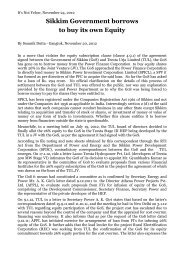Socio-Cultural Environment - Affected Citizens of Teesta (ACT)
Socio-Cultural Environment - Affected Citizens of Teesta (ACT)
Socio-Cultural Environment - Affected Citizens of Teesta (ACT)
You also want an ePaper? Increase the reach of your titles
YUMPU automatically turns print PDFs into web optimized ePapers that Google loves.
The present work is a study on socio-economic resources <strong>of</strong><br />
Sikkim. The mountain state <strong>of</strong> Sikkim is one <strong>of</strong> the smallest states in<br />
India as far as its geographical area is concerned, but one <strong>of</strong> the richest<br />
in terms <strong>of</strong> certain natural resources, especially forests and water - two<br />
vital ingredients <strong>of</strong> its physical environment. Sikkim’s location in the<br />
Eastern Himalayas in a humid tropical regime makes it exceptionally rich<br />
in water and natural vegetation. The socio-economic well being <strong>of</strong> the<br />
state is crucially linked with the judicious utilization as well as<br />
conservation <strong>of</strong> these two vital natural resources.<br />
Sikkim is fortunate to have a very small population. The total<br />
population <strong>of</strong> Sikkim (550,000 approx) is even less than any <strong>of</strong> the major<br />
cities in India. More than fifty per cent <strong>of</strong> Sikkim’s total area lies<br />
uninhabited. The inhospitable terrain and harsh climate have restricted<br />
the extent <strong>of</strong> human habitation in the state within the altitudes <strong>of</strong> 3500 m.<br />
The fact that a very large portion <strong>of</strong> Sikkim lies, above and much beyond<br />
3500 m makes it clear that an extensive landmass is not available for<br />
human activities. However, the small size <strong>of</strong> population <strong>of</strong> the state does<br />
not necessarily mean that the state has low carrying capacity. The<br />
socio-economic carrying capacity <strong>of</strong> the state seems to be flexible and<br />
can be increased substantially if judicious exploitation and distribution <strong>of</strong><br />
resources is ensured.<br />
The mountain environment <strong>of</strong> Sikkim is fragile as well as vulnerable.<br />
However, being comparatively new to modern planning processes, there<br />
is enough scope to learn from the past experiences and problems faced<br />
2<br />
CISMHE




